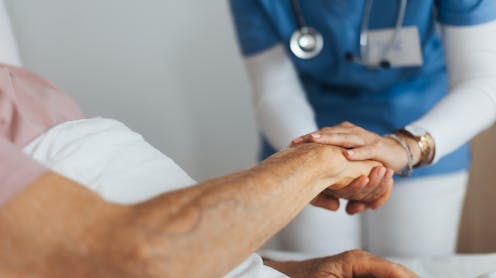Have you turned on your central heating yet? The average British household doesn't typically do so until October 24, according to British Gas. But this year, thanks to soaring energy costs, it may well be later.
My wife Clare and I haven't yet felt the need to turn on the heat. But cold times are certainly coming, and that's going to be very tough on the millions of people who, despite Government support, will struggle to warm their homes.
To help save on energy costs and reduce the risk of blackouts, consumers are being urged to turn down the thermostat.
The Energy Saving Trust, an energy efficiency body, calculates that turning your thermostat down from 20c to 19c should cut your energy bill by around 10 per cent.
If you're fortunate enough to be able to control how well your home is heated, you might like to know that as well as saving money, there are potential health benefits from reducing the thermostat.
However, how low you can go largely depends on your age and state of health.
Young children have more skin surface compared with their body weight than adults, so they lose body heat faster, while people aged 70 plus often struggle in the cold because they not only lose body heat faster, but are often unaware of how cold they really are, which can lead to hypothermia.
If you're fortunate enough to be able to control how well your home is heated, you might like to know that as well as saving money, there are potential health benefits from reducing the thermostat (stock image)
The charity Age UK says that older people's main living areas should ideally be kept at 21c or above, while bedrooms should not drop below 18c. As long as you are healthy and active, you should be able to tolerate and adapt to lower temperatures.
And it may do us good. In a 2014 study, researchers at Garvan Institute of Medical Research in Australia asked a small group of healthy men to spend four months living in a temperature-controlled building while undergoing tests.
For the first month, the rooms were maintained at 24c, apparently a 'thermo-neutral' temperature — where your body doesn't have to work to produce or lose heat.
Then the temperature was dropped to 19c for a month, then raised to 24c the third month, and up to 27c for the final month.
My tips for boosting sleep
As regular readers will know, I'm always on a quest to find ways to get a good night's rest — not just because I struggle with sleep, but also because people tell me how bad theirs is.
So I've made a podcast series designed to help you drift off (the first episode of Sleep Well With Michael Mosley is available on BBC Sounds).
While we were recording, the producer told me to make my voice softer and to speak more slowly. That, along with soothing music, is meant to induce a relaxed mood in the listener. Each episode includes a sleep-inducing tip. The first is about the power of taking slow, deep breaths — thought to reduce the activity of a cluster of cells in your brain, in turn triggering chemical changes that make dropping off easier.
Future episodes will look at using light and bed socks and how to listen to your body and stop worrying about not getting enough sleep. I hope you enjoy the series — but not so much you fall asleep before each episode ends!
One of the most striking findings was that the changing temperatures resulted in big changes in the volunteers' levels of 'brown' fat.
Unlike normal fat, which you may prefer less of, brown fat (which is found in small deposits, typically around the shoulders and neck) is something you should cherish.
That's because it is packed with mitochondria, tiny structures inside cells that act like mini power stations, turning food into energy.
Babies have lots of brown fat, to keep them warm, but adults tend to have much smaller amounts. The good news is that boosting your brown fat levels means you burn more calories, and it should also improve your insulin sensitivity — reducing the amount of insulin your body has to produce after a meal to bring your blood sugar levels back to normal. That should mean less hunger and a lower risk of obesity and type 2 diabetes.
In this study, when the building temperature was dropped to 19c, the men's brown fat increased by an average 42 per cent, while their metabolic rate (the amount of energy expended when the body's at rest) went up by 10 per cent. Their insulin sensitivity also significantly improved.
But when the building temperature went up to 24c, their brown fat melted away, and by 27c, the volunteers' volume of brown fat had fallen to below what it was at the start of the experiment, and with it went all the metabolic benefits.
Endocrinologist Dr Paul Lee, one of the study's authors, pointed out that since the 1990s, the average temperature in our houses has risen from 19c to around 22c, which he said 'is sufficient to quieten down brown fat'.
He added that 'in addition to unhealthy diet and physical inactivity, it is tempting to speculate that the subtle shift in temperature exposure could be a contributing factor to the rise in obesity'.
Most of us could cope with 19c, but what about going lower?
In another study, researchers at Maastricht University Medical Centre in the Netherlands, showed that most people swiftly adapt to colder temperatures.
However, how low you can go largely depends on your age and state of health (stock image)
When volunteers spent six hours a day living at 15c, after ten days not only did their brown fat levels surge, but they said they felt more comfortable and shivered less.
However, there is a concern about damp. I've invested in some indoor room thermometers (they cost under £6 online), which tell me the temperature in different rooms in our house as well as the humidity, which affects how cold you feel.
Our rooms become stuffier and more humid in winter because we close doors and windows to save heat, trapping the moisture inside.
Ideally you want the 'relative humidity' (ie, how much water vapour is in the air) in a room to be between 40 to 60 per cent: if it goes much higher, your clothes start to become clammy, and less effective at retaining your body heat.
If your rooms are damp, you could invest in a dehumidifier (which uses much less energy than heaters). Plants such as peace lilies or spider plants also suck up excess moisture and remove pollutants.
The room where I work is currently just under 17c, the humidity 57 per cent. I'm wearing a thick sweater and have a scarf wrapped around my neck (the idea that you lose most heat through your head is a myth, so I'm not bothering with a hat, though that may change as it gets colder).
Surprisingly enough, there is no legal minimum temperature for a workplace, though an 'Approved Code of Practice' suggests it should 'normally be at least 16c'.
Women seem to feel the cold more, partly because they tend to have less muscle to generate heat and partly because oestrogen dilates the blood vessels at the surface of the skin, which means more body heat escapes. So I think when it comes to turning on the heating, Clare will crack first. We shall see.
A friend has just returned from a chiropractor who manipulated her back, causing a soft crack.
The pain instantly went but she was worried about the 'crack'. I reassured her that this was the sound of gas, that had filled a cavity, escaping —the same thing can happen when you stretch after being hunched over your computer.
It's harmless, but any form of manipulation is best done by someone who knows what they're doing.
New diet that will shake up diabetes care
This week, the NHS announced it is going to roll out a rapid weight-loss programme (850 calories a day, mainly from soups and shakes), to thousands of people with type 2 diabetes.
This is great news, for while rapid weight-loss plans have a bad reputation, large trials have shown that done properly, they're far more effective at helping people lose weight — and keep it off — than standard diets.
They're particularly effective at helping people with type 2 diabetes reduce their blood sugar levels without medication.
This week, the NHS announced it is going to roll out a rapid weight-loss programme (850 calories a day, mainly from soups and shakes), to thousands of people with type 2 diabetes (file image)
One of the scientists pioneering this approach to type 2 diabetes is Roy Taylor, a professor of medicine and metabolism at Newcastle University. When I first met him back in 2014, he told me type 2 diabetes is the result of a build-up of fat in the liver and pancreas, affecting your body's ability to control your blood sugar levels.
He said the solution was to lose about 10 per cent of your bulk, ideally with a rapid weight-loss diet. And despite widespread scepticism, an early trial of his approach showed that people with type 2 diabetes who followed an 850-calorie a day plan lost an average 10kg over 12 weeks —while nearly half managed to reverse their diabetes. Other, larger studies have since had similar results.
When I spoke to Roy a few days ago, he was delighted that the NHS is now fully on board, but is concerned that the funding for the programme 'is not yet secure'. My fingers are crossed.
Source: www.dailymail.co.uk


















 English (United States) ·
English (United States) ·